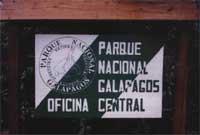Models in Galapagos Islands (and 2)
Most reptiles suffered in the Galapagos Islands, directly or indirectly, when men first entered them; the first sailors also ate Testdo elepzimina or Testdo elepzimopus, the giant tortoise of the Galapagos Islands and their eggs.

If among the reptiles man had not been given to eat land and marine iguanas, the dogs, cats and rats he brought were very harmful, endangering the earthly iguana called Conolophus and leaving better the Amblyrhinchus (seen lately).
Therefore, the steps taken and the investigations that have been followed to observe the giant turtle and the land iguana are of great interest when it comes to saving a type of beast for the benefit of any knowledge and nature. At the Darwin Center in San Cristobal we have learned about these lifesaving actions. Below is how animals have been cared for in a breeding place.
Iguanas
After preventing wild dogs, mountain cats and extremely rats, land iguanas were collected in Bahía Cartago of the island of Isabela in 1982 and in the Cerro-Dragon of the island of Santa Cruz in 1987 were introduced land iguanas born in breeding. For further knowledge and follow-up, each of them was associated with a colourful, coded lead pearl in the dome above his head, to study his growth in freedom every six months.
In Santa Cruz is the seedbed of land iguanas and since 1976 the group of these reptiles has multiplied by the iguanas wrapped in the islands, which with the absence of enemies in the seedbeds, make the humiliations of the eggs that elongate 110-130 days in the best conditions. Then the young people get loose in the corners of the islands of Isabela and Santa Cruz, well cared for and not seen. Those who were north of the island of Seymour also gathered and got into the seedbed. They were subsequently released in neighboring Baltra Island, an airport area with no human inhabitants.

Therefore, four steps were taken: collecting those in danger of extinction, growing in the countryside, cleaning the remains of the islands and creating places different from the young iguanas.
Giant turtles
In Latin, I have two or three names that I think the last is Geochelonia elephandiopus, approved by UZEI, which we have not changed. This turtle, whose mountain cats, wild dogs and rats were enemies to avoid man and species, was in danger of extinction in 1965 because of enemies.
For this project, most of the turtles concentrated in the land of Ecuador and in the houses. In Quito there were also in schools and. Then they could not give in to the desert, unlike iguanas, because they had lost the sense of wildlife. It was not with them to free the male and the female: most of the gathered will live captive and die.
As was done with Iguana, the remains of the place were banned or restricted, predators took care of the places of laying eggs, but it was not enough and enough to increase the number of turtles. Finally they gathered at the breeding site, the corrals, which when the turtle was insufficient, collected the eggs to save them from the clutches of birds. In this way, the smaller turtle of the Espanola island was preserved, fifteen of the latter were collected and now loose 350, which reproduce in the wild...
However, most giant laying turtles still remain in the field. The young, to escape the danger of predators, are not sent to the islands with turtles until their arrival. Since 1971, 1,100 giant turtles have been distributed from the breeding site to the wild areas. For the growth of giant turtles strict rules are met.

Raising eggs could last between 85 and 200 days, forming children in November or May. As soon as they are born they are given green grass, from the mountain ones or from the garden of the Darwin research center. Measured every three months, they grow as pets for two or three years. Then they are given a year of wild food, "thorny apple" and rougher food. They live with more room in a greater corridor to get used to freedom. Four years later they are sent to nature. They are sent to an island to lead their wildlife.
There they also carry a nice job, or as they say to begin, that the continuity of these beasts is not enough to say that man has won the battle for the death of a species.





